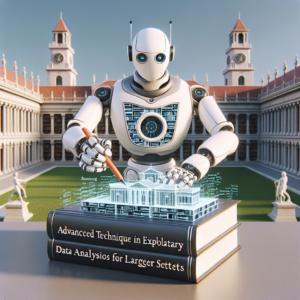1. Unveiling the Power of Big Data Analysis
Big data analysis has revolutionized the way businesses, scientists, and governments make decisions. By harnessing large datasets, organizations can uncover patterns and insights that were previously hidden. This section explores the transformative impact of big data analysis and its essential techniques.
One of the primary advantages of big data analysis is its ability to improve decision-making processes. With the right tools and techniques, big data allows for more accurate predictions and smarter decisions in real-time. This capability is crucial in industries like finance, healthcare, and retail, where strategic decisions need to be based on the latest information.
Furthermore, big data analysis employs advanced algorithms and machine learning techniques to process and analyze vast amounts of data. Techniques such as data mining, natural language processing, and neural networks are commonly used to extract valuable information from large datasets. These methods enable analysts to handle complex and varied data structures, from unstructured text to intricate network data.
However, the power of big data is not just in its size but in its ability to be integrated and analyzed quickly and efficiently. Tools like Apache Hadoop and Spark have been pivotal in providing the necessary infrastructure for processing large datasets. They allow for distributed processing, which means that data can be processed in parallel, significantly speeding up analysis times.
In conclusion, the power of big data analysis lies in its capacity to provide deep insights and actionable intelligence across various domains. By leveraging advanced EDA techniques, organizations can navigate the complexities of large datasets and gain a competitive edge in their respective fields.
2. Core Advanced EDA Techniques for Large Datasets
Advanced EDA techniques are crucial for extracting meaningful insights from large datasets. This section delves into the methodologies that enable effective analysis of big data.
Firstly, dimensionality reduction techniques such as Principal Component Analysis (PCA) and t-Distributed Stochastic Neighbor Embedding (t-SNE) are vital. They help simplify complex data sets by reducing the number of variables under consideration, without losing essential information. This simplification is crucial for both visualization and further analysis.
Another critical technique is cluster analysis. Methods like K-means clustering and hierarchical clustering allow data scientists to identify inherent groupings within the data. This is particularly useful in customer segmentation, genetics, and market research, where understanding the structure of data is key.
Anomaly detection is also a significant part of advanced EDA, especially in large datasets where outliers can significantly skew results. Techniques such as Isolation Forests and DBSCAN are employed to detect anomalies that could indicate fraud, system failures, or rare events.
Moreover, association rule learning is used to find interesting relationships between variables in large databases. This technique is often used in market basket analysis to discover products frequently bought together.
Lastly, the integration of machine learning algorithms into EDA processes enhances the ability to automate and scale data analysis efforts. Supervised and unsupervised learning models can predict outcomes and uncover patterns, respectively, making them indispensable in the context of big data.
In summary, leveraging these advanced EDA techniques allows analysts to handle the complexities of large datasets effectively, providing deeper insights and driving strategic decisions across various industries.
2.1. Machine Learning Models in EDA
Machine learning models play a pivotal role in exploratory data analysis (EDA) for large datasets. This section highlights how these models are integrated into EDA to enhance data understanding and prediction accuracy.
Supervised learning models such as linear regression and decision trees are extensively used to predict outcomes based on historical data. These models are crucial for tasks where the relationship between input variables and a continuous or categorical output needs to be modeled. For example, predicting customer churn based on usage patterns falls under this category.
Unsupervised learning models, including k-means clustering and principal component analysis (PCA), are employed to discover the underlying structure of the data without pre-existing labels. These models help identify segments or groups within the data, which can be critical for market segmentation or identifying new customer demographics.
Reinforcement learning is another advanced technique used in EDA, particularly in dynamic environments where data is continuously evolving. This model learns to make decisions by receiving feedback from its actions, rather than from direct instruction, making it ideal for real-time decision-making systems.
Moreover, the use of neural networks, especially deep learning models, has surged due to their ability to handle vast amounts of data and learn complex patterns. These models are particularly useful in image and speech recognition tasks embedded within larger datasets.
Incorporating these machine learning models into EDA not only accelerates the analytical process but also provides more depth and accuracy in the insights derived. By leveraging these models, data scientists can automate the detection of patterns and anomalies, predict future trends, and make data-driven decisions more effectively.
Overall, the integration of machine learning models into EDA represents a significant advancement in handling and analyzing large datasets, enabling businesses to harness the full potential of their data assets.
2.2. Visualization Tools for Complex Data
Visualization tools are essential in exploratory data analysis, especially when dealing with large datasets. They help in making the complex data comprehensible by transforming it into visual representations.
Tools like Tableau, Power BI, and Google Charts enable users to create interactive dashboards and complex graphs. These tools support a variety of data visualizations such as heat maps, scatter plots, and time series graphs, which are crucial for spotting trends and outliers in big data.
For more technical users, programming libraries such as Matplotlib, Seaborn, and Plotly in Python offer flexibility in customizing plots. These libraries allow for the creation of highly detailed and specific visualizations that can be integrated directly into data analysis workflows.
Another powerful tool is D3.js, a JavaScript library that lets developers produce dynamic, interactive data visualizations in web browsers. It is particularly useful for creating custom charts and real-time data visualization.
Effective use of these tools not only aids in understanding the data but also in communicating findings clearly and effectively. By leveraging the right visualization tools, data scientists can provide actionable insights that are easily digestible by stakeholders.
In summary, the right visualization tools are indispensable in the toolkit of anyone working with big data analysis. They bridge the gap between raw data and strategic insight, enabling data scientists to showcase the value hidden within large datasets.
3. Integrating Big Data Tools with EDA
Integrating big data tools with exploratory data analysis (EDA) is essential for managing and analyzing large datasets effectively. This section discusses key tools and their integration strategies.
Apache Hadoop is foundational in the big data ecosystem, known for its ‘Hadoop Distributed File System’ (HDFS) and MapReduce programming model. Hadoop enables scalable processing of large data volumes across a distributed computing environment, making it ideal for EDA involving massive datasets.
Apache Spark is another critical tool, offering faster processing capabilities than Hadoop due to its in-memory cluster computing. Spark also provides a rich ecosystem, including Spark SQL for data querying, MLib for machine learning, GraphX for graph processing, and Spark Streaming.
For real-time data processing, Apache Kafka is used to build real-time data pipelines and streaming applications. It allows data ingestion from multiple sources and makes the data available to multiple consumers, facilitating more dynamic EDA processes.
Integrating these tools requires a robust data infrastructure and skilled data engineers to implement and maintain the systems. The integration enables data scientists to focus more on drawing insights rather than managing data logistics.
Effective integration of these big data tools with EDA techniques not only enhances the efficiency of data analysis but also expands the potential for discovering deeper insights in large datasets. This synergy is crucial for businesses looking to leverage data-driven strategies for competitive advantage.
In summary, the combination of big data tools and EDA techniques provides a powerful framework for handling the complexities and scale of modern data sets, driving innovation and strategic decisions across industries.
4. Case Studies: Real-World Applications of Advanced EDA
Advanced EDA techniques have been pivotal in transforming data into actionable insights across various industries. This section highlights several case studies where these methods have significantly impacted real-world scenarios.
In the healthcare sector, big data analysis has enabled predictive modeling that anticipates patient outcomes. For instance, using large datasets, hospitals can predict patient readmission risks and improve care plans accordingly. Techniques like cluster analysis help segment patients based on risk factors, enhancing personalized treatment strategies.
The retail industry benefits from advanced EDA techniques through improved customer segmentation and inventory management. Retail giants use association rule learning to understand purchasing patterns, which helps in optimizing stock levels and arranging store layouts according to consumer behavior.
In finance, anomaly detection algorithms are crucial for fraud detection. Financial institutions analyze transaction data to identify unusual patterns that may indicate fraudulent activity. Machine learning models are trained on historical data to detect anomalies in real-time, safeguarding both the institution and its customers.
The energy sector utilizes time series analysis in EDA to forecast demand and optimize energy distribution. Predictive models analyze consumption patterns and predict future demand with high accuracy, allowing for more efficient energy management and distribution planning.
Each of these case studies demonstrates the versatility and necessity of advanced EDA techniques in extracting meaningful information from large datasets. By applying these methods, organizations not only enhance operational efficiency but also drive innovation and strategic decision-making.
In summary, real-world applications of advanced EDA showcase its critical role in leveraging big data to solve complex problems and make informed decisions across diverse sectors.
5. Optimizing Performance in Data Analysis
Optimizing performance in data analysis is crucial for efficiently handling large datasets. This section outlines strategies to enhance the speed and accuracy of your data analysis processes.
Efficient Data Storage: Choosing the right storage solution is foundational. Technologies like columnar storage formats (e.g., Parquet) optimize both storage efficiency and query speed, especially for analytical workloads that involve large datasets.
Data Indexing: Implementing indexing can drastically reduce the time it takes to retrieve information from a database. Indexes support quicker data retrieval by minimizing the amount of data scanned during queries.
Parallel Processing: Utilizing parallel processing frameworks such as Apache Spark helps distribute data processing tasks across multiple nodes. This method significantly speeds up data analysis tasks by handling large volumes of data simultaneously.
In-memory Computing: By storing data in RAM instead of slower disk-based storage, in-memory computing allows for faster data processing. This approach is particularly effective in speeding up real-time data analysis and complex calculations.
Algorithm Optimization: Selecting and tuning algorithms that are well-suited for your specific data characteristics and analysis needs can lead to more efficient performance. For example, using vectorized operations in Python’s NumPy library can perform operations much faster than traditional loops.
In summary, optimizing data analysis performance involves a combination of choosing the right tools, implementing efficient data management practices, and selecting appropriate computing techniques. These strategies are essential for dealing with the complexities of advanced EDA techniques and big data analysis, ensuring that insights are derived quickly and accurately.
6. Future Trends in EDA for Big Data
The landscape of Exploratory Data Analysis (EDA) is continually evolving, especially with the increasing scale of large datasets. This section explores the anticipated trends that will shape the future of EDA in the realm of big data.
Automation in Data Analysis: Automation technologies are expected to become more sophisticated, enabling more comprehensive and faster analysis without human intervention. This shift will likely enhance the efficiency of data processing and the accuracy of insights derived from big data.
Integration of AI and Machine Learning: AI and machine learning will play a more significant role in EDA, not just for predictive analytics but also for data preparation and cleaning. These technologies will help in uncovering complex patterns and providing deeper insights from data that were previously not accessible.
Advancements in Real-time Analytics: As businesses demand faster decision-making capabilities, real-time analytics will become more prevalent. Technologies that support streaming analytics will allow organizations to perform EDA on-the-fly, making immediate data-driven decisions possible.
Greater Emphasis on Data Privacy: With the increasing scrutiny on data privacy, future EDA tools are likely to incorporate more robust mechanisms to ensure data security and compliance with global data protection regulations. This will be crucial in maintaining trust and integrity in big data analysis.
In summary, the future of EDA for big data looks promising with advancements in technology that aim to streamline processes, enhance accuracy, and ensure data privacy. These developments will empower organizations to leverage their data assets more effectively, driving innovation and strategic growth.



